SERION ELISA classic Brucella IgG/IgM/IgA
SERION ELISA classic Brucella IgG/IgM/IgA
SERION ELISA classic Brucella IgG/IgM/IgA
You also want an ePaper? Increase the reach of your titles
YUMPU automatically turns print PDFs into web optimized ePapers that Google loves.
<strong>SERION</strong> <strong>ELISA</strong> <strong>classic</strong> <strong>Brucella</strong> <strong>IgG</strong>/<strong>IgM</strong>/<strong>IgA</strong><br />
CONTENTS<br />
1. INTENDED USE: For sale in the U.S. for Research Use Only. Not for use in diagnostic<br />
procedures.<br />
2. BACKGROUND<br />
3. <strong>SERION</strong> <strong>ELISA</strong> <strong>classic</strong> - TEST PRINCIPLE<br />
4. COMPONENTS OF THE KIT<br />
5. MATERIAL REQUIRED BUT NOT SUPPLIED<br />
6. STORAGE AND STABILITY<br />
7. TEST PROCEDURE <strong>SERION</strong> <strong>ELISA</strong> <strong>classic</strong><br />
7.1 Evidence of deterioration<br />
7.2 Sample preparation and storage<br />
7.3 Preparation of kit reagents<br />
7.4 Overview - test procedure<br />
7.5 Test procedure<br />
8. TEST EVALUATION<br />
8.1 Single-point quantification with the 4PL method<br />
8.2 Criteria of validity<br />
8.3 Calculation <strong>SERION</strong> <strong>ELISA</strong> <strong>classic</strong> <strong>Brucella</strong> <strong>IgG</strong>/<strong>IgM</strong>/<strong>IgA</strong> (quantitative)<br />
9. STATEMENTS OF WARNING<br />
9.1 Statements of warning<br />
9.2 Disposal<br />
10. BIBLIOGRAPHY<br />
english 1
<strong>SERION</strong> <strong>ELISA</strong> <strong>classic</strong> <strong>Brucella</strong> <strong>IgG</strong>/<strong>IgM</strong>/<strong>IgA</strong><br />
Enzyme Immunoassay for detection of human antibodies (<strong>IgG</strong>/<strong>IgM</strong>/<strong>IgA</strong>)<br />
- For sale in the U.S. for Research Use Only. Not for use in diagnostic<br />
procedures.<br />
<strong>IgG</strong>-Kit (quantitative) order number: ESR116G<br />
<strong>IgM</strong>-Kit (quantitative) order number: ESR116M<br />
<strong>IgA</strong>-Kit (quantitative) order number: ESR116A<br />
Tests evaluated: Dade Behring BEP ® III / BEP ® 2000, DSX, manually<br />
1. INTENDED USE<br />
<strong>SERION</strong> <strong>ELISA</strong> <strong>classic</strong> <strong>Brucella</strong> <strong>IgG</strong>/<strong>IgM</strong>/<strong>IgA</strong> are quantitative and qualitative tests for<br />
detection of human antibodies in serum and plasma directed against <strong>Brucella</strong> species. For<br />
sale in the U.S. for Research Use Only. Not for sue in diagnostic procedures.<br />
2. BACKGROUND<br />
<strong>Brucella</strong> ssp. are gram-negative amotile bacteria which live as intracellular parasites in a<br />
wide spectrum of farm animals. Human infection is mainly caused by <strong>Brucella</strong> melitensis<br />
(“Malta fever”), <strong>Brucella</strong> abortus (“Morburs Bang”), <strong>Brucella</strong> suis and <strong>Brucella</strong> canis.<br />
This bacteria, which can be transmitted by infected animals (zoonosis), their excrements<br />
and contaminated food, most often causes moderate or high fever. Undulating fever with<br />
afebrile intervals are characteristic for <strong>Brucella</strong> melitensis and <strong>Brucella</strong> suis infections.<br />
Accurate diagnosis of Brucellosis most often relies on direct detection of the pathogen or<br />
detection of specific antibody response in serum or CSF. Direct pathogen detection in<br />
culture systems can be performed with samples of blood, bone marrow, synovial fluid or<br />
urine. More rapid results can be obtained with serological methods: agglutination, coombstest,<br />
Complement Fixation Test (CFT).<br />
3. <strong>SERION</strong> <strong>ELISA</strong> <strong>classic</strong> - TEST PRINCIPLE<br />
english 2
Microtest plates are coated with antigens. This constitutes the solid phase. Sample is added<br />
to the plates and any antibodies specific for the antigen present will bind to the solid phase.<br />
After removal of unbound material, anti-human <strong>IgG</strong>, <strong>IgA</strong> or <strong>IgM</strong> conjugated to an enzyme<br />
(alkaline phosphatase) is allowed to react with the immune complex. After removal of<br />
excess conjugate by washing, an appropriate substrate (para-nitrophenylphosphate) is<br />
added, with which the conjugated enzyme reacts producing a coloured derivative of the<br />
substrate. The color intensity is proportional to the level of specific antibody bound and can<br />
be quantified photometrically.<br />
english 3
4. COMPONENTS OF THE KIT<br />
Test components amount /<br />
volume<br />
Break apart microtiter test strips each with 8 antigen coated single wells (altogether 96),<br />
12<br />
1 frame<br />
the coating material is inactivated<br />
Standard serum (ready-to-use)<br />
Human serum in phosphate buffer with protein; negative for anti-HIV-Ab, anti-HBs-Ag<br />
(Hepatitis B-Virus-surface antigen) and anti-HCV-Ab; preservative: < 0.1 % sodium azide<br />
colouring: Amaranth O<br />
Negative control serum (ready-to-use)<br />
Human serum in phosphate buffer with protein; negative for anti-HIV, anti-HBs (Hepatitis B-<br />
Virus-surface antigen) and anti-HCV; preservative: < 0.1 % sodium azide<br />
colouring: Lissamin green V<br />
Anti-human-<strong>IgG</strong>-, <strong>IgA</strong>-, <strong>IgM</strong>-conjugate (ready-to-use)<br />
Anti-human-<strong>IgG</strong>, -<strong>IgA</strong>, -<strong>IgM</strong> from goat (polyclonal), conjugated to alkaline phosphatase,<br />
stabilized with protein stabilization solution<br />
preservative: 0.01 % methylisothiazolone, 0.01 % bromnitrodioxane<br />
Washing solution concentrate (sufficient for 1 litre)<br />
Sodium chloride solution with Tween 20, 30 mM Tris<br />
preservative: < 0.1 % sodium azide<br />
Dilution buffer<br />
Phosphate buffer with protein and Tween 20;<br />
preservative: < 0.1 % sodium azide<br />
0.01 g/l Bromphenol blue sodium salt<br />
Stopping solution<br />
1.2 N sodium hydroxide<br />
Substrate (ready-to-use)<br />
Para-nitrophenylphosphate, solvent free buffer<br />
preservative: < 0.1 % sodium azide<br />
(Substrate in unopened bottle may have a slightly yellow coloring. This does not reduce<br />
the quality of the product!)<br />
Quality control certificate with standard curve and evaluation table<br />
(quantification of antibodies in IU/ml or U/ml)<br />
2 x 2 ml<br />
2 ml<br />
13 ml<br />
33.3 ml<br />
2 x 50ml<br />
15 ml<br />
13 ml<br />
1<br />
english 4
5. MATERIAL REQUIRED BUT NOT SUPPLIED<br />
- common laboratory equipment<br />
- for the <strong>IgM</strong>-<strong>ELISA</strong>: <strong>SERION</strong> Rf-Absorbent (Order no. Z200/20ml)<br />
- photometer for microtiter plates with filter, wavelength 405 nm, recommended<br />
reference wavelength 620 nm - 690 nm (e.g. 650 nm)<br />
- incubator 37°C<br />
- moist chamber<br />
- distilled water<br />
6.STORAGE AND STABILITY<br />
Reagent Storage Stability<br />
microtiter strips<br />
(antigen)<br />
control sera /<br />
standard sera<br />
conjugate<br />
dilution buffer<br />
washing solution<br />
substrate<br />
after opening at 2-8°C in closed aluminum bag with<br />
desiccant<br />
Strips which are not used must be stored in the press-seal bag<br />
of aluminum compound foil under dry and airtight<br />
conditions!<br />
after opening at 2-8°C<br />
ready-to-use solution, at 2-8°C<br />
Avoid contamination (sterile tips!)<br />
after opening at 2-8°C<br />
Discard cloudy solutions!<br />
unopened<br />
concentrate after opening at 2-8°C<br />
working dilution at 2-8°C<br />
working dilution at room temperature<br />
Bottles used for the working dilution should be cleaned<br />
regularly, discard cloudy solutions.<br />
ready-to-use solution at 2-8°C, protected from light!<br />
Avoid contamination (sterile tips!) Discard when solution<br />
turns yellow (extinction against distilled water. > 0.25).<br />
4 weeks<br />
until expiry date;<br />
24 months from<br />
date of production<br />
until expiry date<br />
28 months from<br />
date of production<br />
24 months<br />
until expiry date;<br />
36 months from<br />
date of production<br />
until expiry date<br />
2 weeks<br />
1 week<br />
until expiry date<br />
24 months from<br />
date of production<br />
stopping solution after opening at room temperature until expiry date<br />
english 5
7. TEST PROCEDURE <strong>SERION</strong> <strong>ELISA</strong> <strong>classic</strong><br />
7.1 Evidence of deterioration<br />
Only use <strong>SERION</strong> <strong>ELISA</strong> <strong>classic</strong> reagents for test procedure, since all reagents are matched.<br />
In particular standard and control sera are defined exclusively for the test kit to be used. Do<br />
not use them in other lots. Dilution buffer, washing solution and substrate solution can be<br />
used for all <strong>SERION</strong> <strong>ELISA</strong> <strong>classic</strong> kits irrespective of the lot and the test.<br />
There are three different conjugate concentrations for each immunoglobulin class: LOW,<br />
MEDIUM, HIGH<br />
The classification is written on each label as follows:<br />
e.g.<br />
<strong>IgG</strong> + lowly concentrated <strong>IgG</strong> conjugate<br />
<strong>IgG</strong> ++ medium concentrated <strong>IgG</strong> conjugate<br />
<strong>IgG</strong> +++ highly concentrated <strong>IgG</strong> conjugate<br />
In rare cases the use of special conjugate is necessary to guarantee consistent quality for our<br />
products. Special conjugates are produced in a separate lot and do not wear the “+” sign.<br />
Therefore, special conjugates are not exchangeable with other conjugates.<br />
Please pay close attention to notifications on labels!<br />
Unopened, all components of the <strong>SERION</strong> <strong>ELISA</strong> <strong>classic</strong> kits may be used up to the dates<br />
given on the labels, if stored at +2°C to +8°C. Complete stability and storage data are<br />
described under ”6. Storage and Stability ”.<br />
Each reagent has been calibrated and optimized for the test. Dilution or alteration of these<br />
reagents may result in a loss of sensitivity.<br />
Avoid exposure of reagents to strong light during storage and incubation. Reagents must<br />
be tightly closed to avoid evaporation and contamination with microorganisms since<br />
incorrect test results could occur due to interference from proteolytic enzymes.<br />
To open the press-seal bag please cut off the top of the marked side, only. Do not use the<br />
strips if the aluminum bag is damaged or if the press-seal bag with remaining strips and<br />
desiccant was not properly reclosed.<br />
Bring all reagents to room temperature before testing.<br />
Use aseptic techniques for removing aliquots from the reagent tubes to avoid<br />
contamination. To avoid false positive results ensure not to contact or sprinkle the top-walls<br />
of wells while pipetting conjugate. Be careful not to mix the caps of the bottles and/or vials.<br />
Reproducibility depends on thorough mixing of the reagents. Shake the flasks containing<br />
control sera before use and also all samples after dilution (e.g. by using a monomixer).<br />
Be sure to pipette carefully and comply with the given incubation times and temperatures.<br />
Significant time differences between pipetting the first and last well of the microtiter plate<br />
english 6
when filling samples/control sera, conjugate or substrate may result in different<br />
„pre incubation“ times, which may influence the precision and reproducibility of the<br />
results.<br />
Optimum results can only be achieved if <strong>SERION</strong> <strong>ELISA</strong> <strong>classic</strong> instructions are followed<br />
strictly.<br />
The test is not valid, if the lot-specific validation criteria on the quality control certificate are<br />
not fulfilled.<br />
Inadequate washing will affect the test results:<br />
The washing procedure should be carried out carefully. If the washing procedure is carried<br />
out automatically follow the instruction manual of the respective washer. Flat bottom wells<br />
are used for <strong>SERION</strong> <strong>ELISA</strong> <strong>classic</strong>. All wells should be filled with equal volumes of<br />
washing buffer. At the end of the procedure ensure that the wells are free of all washing<br />
buffer by tapping the inverted microtest plate on a paper towel. Avoid foam! Do not scratch<br />
coated wells during washing and aspiration. If using an automated washer, ensure it is<br />
operating correctly.<br />
7.2 Sample preparation and storage<br />
Lipaemic, hemolytic or icteric samples should only be tested with reservations although in<br />
our testing no negative influence has been found. Obviously contaminated samples (serum<br />
or plasma) should not be tested due to the risk of wrong results.<br />
Serum or plasma (EDTA, citrate, heparin) collected according to standard laboratory<br />
methods are suitable samples.<br />
Samples must not be thermally inactivated.<br />
7.2.1 Sample preparation<br />
Before running the test, samples must be diluted in dilution buffer (V 1 + V 2) as follows:<br />
<strong>SERION</strong> <strong>ELISA</strong> <strong>classic</strong> <strong>Brucella</strong> <strong>IgG</strong>/<strong>IgA</strong><br />
V 1 + V 2 = 1+100 add 10 µl sample<br />
each to 1000 µl dilution buffer<br />
After dilution and before pipetting into the microtiter plate the samples must be mixed<br />
thoroughly to prepare a homogenous solution.<br />
english 7
<strong>SERION</strong> <strong>ELISA</strong> <strong>classic</strong> <strong>Brucella</strong> <strong>IgM</strong><br />
Rheumatoid factors are autoantibodies mainly of the <strong>IgM</strong>-class, which preferably bind to<br />
<strong>IgG</strong>-immune-complexes. The presence of non-specific <strong>IgM</strong>-antibodies (rheumatoid factors)<br />
can lead to false-positive results in the <strong>IgM</strong>-assay. Furthermore, the possibility exists, that<br />
weak-binding pathogen-specific <strong>IgM</strong>-antibodies are displaced by stronger-binding<br />
<strong>IgG</strong>-antibodies. In this case, <strong>IgM</strong>-detection can lead to false-negative results. Therefore it is<br />
necessary to pretreat samples with rheumatoid factor-absorbens prior to <strong>IgM</strong> detection<br />
(<strong>SERION</strong> Rheumatoid Factor-Absorbent, Order-No. Z200 (20 ml/100 tests)).<br />
Before running the test, rheumatoid factor-absorbent (V 1) must be diluted 1+4 in dilution<br />
buffer (V 2).<br />
V 1 + V 2 = 1 + 4 add 200 µl Rf-absorbent<br />
each to 800 µl<br />
dilution buffer<br />
Samples (V 4) must be diluted in this Rf-dilution buffer (V 3)<br />
V 4 + V 3 = 1+100 add 10 µl sample<br />
each to 1000 µl Rf-dilution buffer<br />
7.2.2 Sample storage<br />
The stoppered samples can be stored in a refrigerator up to 7 days at 2-8°C. Extended<br />
storage is possible at ≤ -20°C.<br />
Avoid repeated freezing and thawing of samples.<br />
Diluted samples can be stored at 2-8°C for one week.<br />
english 8
7.3 Preparation of kit reagents<br />
7.3.1 Microtest strips<br />
Microtest strips in frame are packed with desiccant in an aluminum bag. Take<br />
unrequired cavities out of the frame and put them back into the press-seal bag. Close<br />
press-seal bag carefully to ensure airtight conditions.<br />
7.3.2 Control sera / standard sera<br />
Control and standard sera are ready-to-use and must not be diluted any further. They<br />
can be used directly for the test run.<br />
For each test run and for each test system - independent of the number of microtest<br />
strips to be used - control and standard sera must be included. The cut-off-control<br />
should be set up in duplicate. With the quantitative tests the standard serum should<br />
also be set up in duplicate.<br />
Do not treat control sera with Rf-absorbent.<br />
7.3.3 Anti-human-<strong>IgG</strong>-, <strong>IgM</strong>- or <strong>IgA</strong>-AP-conjugate (ready-to-use)<br />
Please do not mix up conjugates from different kits. They are optimized for each lot.<br />
Conjugates are exchangeable as described in 7.1.<br />
Avoid contamination of ready-to-use conjugates (please pour sufficient for test into a<br />
secondary container to avoid repeatedly pipetting from the original bottle).<br />
7.3.4 Washing solution<br />
Dilute washing buffer concentrate (V 1) 1:30 with aqua dest. to a final volume of V 2.<br />
Example:<br />
buffer concentrate (V 1) final volume (V 2)<br />
33.3 ml 1000 ml<br />
1 ml 30 ml<br />
7.3.5 Dilution buffer for samples (ready-to-use)<br />
7.3.6 Substrate (ready-to-use)<br />
To avoid contamination use gloves. For pipetting substrate solution use sterile tips<br />
only!<br />
7.3.7 Stopping solution (ready-to-use)<br />
english 9
7.4 Overview - test procedure<br />
<strong>Brucella</strong><br />
<strong>IgG</strong>/<strong>IgM</strong>/<strong>IgA</strong> quantitative<br />
in case of <strong>IgM</strong>-detection absorption of rheumatoid factor!<br />
sample dilution<br />
1 + 100<br />
<br />
Pipette diluted samples and ready-to-use control sera /<br />
standard sera into the microtest wells (100 µl)<br />
<br />
INCUBATION 60 min./37°C<br />
moist chamber<br />
<br />
WASH<br />
<br />
Pipette conjugate solution (100 µl)<br />
<br />
INCUBATION 30 min./37°C<br />
moist chamber<br />
<br />
WASH<br />
<br />
Pipette substrate solution (100 µl)<br />
<br />
INCUBATION 30 min./37°C<br />
moist chamber<br />
<br />
Pipette stopping solution (100 µl)<br />
<br />
READ EXTINCTION AT 405 nm<br />
english 10
7.5 Test procedure<br />
1. Place the required number of cavities in the frame and prepare a protocol sheet.<br />
2. Add each 100 µl of diluted sample or ready-to-use controls into the appropriate wells<br />
of microtest strips. Spare one well for substrate blank, e.g.:<br />
<strong>IgG</strong>/<strong>IgM</strong>/<strong>IgA</strong> quantitative<br />
well A1 substrate blank<br />
well B1 negative control<br />
well C1 standard serum<br />
well D1 standard serum<br />
well E1 sample 1....<br />
3. Sample incubation for 60 minutes (+/- 5 min) at 37°C (+/- 1°C) in moist chamber<br />
4. After incubation wash all wells with washing solution (by automated washer or<br />
manually):<br />
- aspirate or shake out the incubation solution<br />
- fill each well with 300 µl washing solution<br />
- aspirate or shake out the washing buffer<br />
- repeat the washing procedure 3 times (altogether 4 times!)<br />
- dry by tapping the microtest plate on a paper towel<br />
5. Addition of conjugate<br />
Add 100 µl of <strong>IgG</strong>-/<strong>IgM</strong>-/<strong>IgA</strong>-conjugate (ready-to-use) to the appropriate well (except<br />
substrate blank)<br />
6. Conjugate incubation for 30 minutes (+/- 1 min) * at 37°C (+/- 1°C) in moist chamber.<br />
7. After incubation wash all wells with washing solution (see above)<br />
8. Addition of substrate<br />
Add 100 µl substrate solution (ready-to-use) to each well (including well for substrate<br />
blank!)<br />
9. Substrate incubation for 30 minutes (+/- 1 min) * at 37°C (+/- 1°C) in moist chamber.<br />
10. Stopping of the reaction<br />
Add 100 µl stopping solution to each well, shake microtest plate gently to mix.<br />
11. Read optical density<br />
Read OD within 60 minutes at 405 nm against substrate blank, reference wave length<br />
between 620 nm and 690 nm (e.g. 650 nm).<br />
* Please note, that under special working-conditions internal laboratory adaptations of the incubation<br />
times could be necessary.<br />
english 11
8. TEST EVALUATION<br />
<strong>SERION</strong> <strong>ELISA</strong> <strong>classic</strong> <strong>Brucella</strong> <strong>IgG</strong>/<strong>IgM</strong>/<strong>IgA</strong> (quantitative)<br />
8.1 Single-point quantification with the 4PL method<br />
Optimized assignment of extinction signals to quantitative values is guaranteed by using<br />
non-linear functions, which adjust a sigmoide curve without any further transformation to<br />
OD-values.<br />
Determination of antibody concentrations with the <strong>SERION</strong> <strong>ELISA</strong> <strong>classic</strong> is carried out by<br />
the logistic-log-model (4 PL; 4 parameter) which is ideal for exact curve-fitting. It is based<br />
on the formula:<br />
OD = A +<br />
1 + e<br />
D - A<br />
B(C - In conc.)<br />
The parameters A, B, C, and D are representative for the exact shape of the curve:<br />
1. lower asymptote parameter A<br />
2. slope of the curve parameter B<br />
3. turning point parameter C<br />
4. upper asymptote parameter D<br />
For each lot the standard curve is evaluated by Institut Virion\Serion GmbH (Würzburg,<br />
Germany) in several repeated test runs under optimal conditions. Time consuming and cost<br />
intensive construction of the standard curve by the user is not necessary.<br />
For evaluation of antibody concentrations a lot specific standard curve as well as a lot<br />
specific evaluation table is included with each test kit. Appropriate evaluation software is<br />
available on request.<br />
To compensate for normal test variations and also for test run control a standard serum is<br />
used in each individual test run. For this control serum a ‘’reference value’’ with a validity<br />
range is determined by the quality control of the producer. Within this range a correct<br />
quantification of antibody concentration is ensured. Since the standard serum is not<br />
necessarily a positive control, the value of the standard serum may be borderline or<br />
negative in some <strong>ELISA</strong> tests.<br />
english 12
8.2 Criteria of validity<br />
- the substrate blank must be OD < 0.25<br />
- the negative control must be negative<br />
- quantitative <strong>ELISA</strong>: the mean OD-value of the standard serum must be within the<br />
validity range, which is given on the lot specific quality control certificate of the kit<br />
(after subtraction of the substrate blank!)<br />
- qualitative <strong>ELISA</strong>: the mean OD-value of the positive control must be within the<br />
validity range, which is given on the lot specific quality control certificate of the kit<br />
(after subtraction of the substrate blank!)<br />
- the variation of OD-values may not be higher than 20%.<br />
If these criteria are not met, the test is not valid and must be repeated.<br />
8.3 Calculation<br />
<strong>SERION</strong> <strong>ELISA</strong> <strong>classic</strong> <strong>Brucella</strong> <strong>IgG</strong>/<strong>IgM</strong>/<strong>IgA</strong> (quantitative)<br />
8.3.1 Non-automated evaluation<br />
For the test evaluation a standard curve and an evaluation table are included in the test kit<br />
so that the obtained OD-values may be assigned to the corresponding antibody activity.<br />
The reference value and the validity range of the standard serum is given on the evaluation<br />
table (quality control certificate).<br />
The blank (A1) must be subtracted from all OD-values prior to the evaluation.<br />
Method 1: Qualitative Evaluation<br />
To fix the cut-off ranges please multiply the mean value of the measured standard-OD with<br />
the numerical data of the certificate of quality control (see special case formulas), e.g.:<br />
OD = 0.502 x MW(STD) with upper cut-off<br />
OD = 0.352 x MW(STD) with lower cut-off<br />
If the measured mean absorbance value of the standard serum is 0.64, the range of the cutoff<br />
is in between 0.225-0.321.<br />
Method 2: Continuous determination of antibody activities using the standard curve.<br />
So called interassay variations (day to day deviations and laboratory to laboratory<br />
deviations) are compensated by multiplication of the current measured value obtained with<br />
a sample with the correction factor F. This factor is calculated as follows:<br />
F =<br />
OD-reference value (of standard serum)<br />
OD-current value (of standard serums)<br />
english 13
The procedure is necessary to adjust the current level of the test of the user with the lotspecific<br />
standard curve.<br />
First, daily deviations have to be corrected by calculating a factor (correction factor F):<br />
1. The mean of the two OD-values of the standard serum has to be calculated and checked<br />
that it is within the given validity range.<br />
2. Calculation of the factor "F": the given reference value is divided by the mean of the<br />
extinction of the standard serum:<br />
F = reference value extinction standard serum / mean value extinction standard serum.<br />
3. All measured values of samples are multiplied by "F".<br />
4. Antibody activities in IU/ml or U/ml can be determined from the standard curve with<br />
the corrected values.<br />
english 14
8.3.2 Automatic test evaluation with<br />
<strong>SERION</strong> easy base 4PL-Software/<strong>SERION</strong> evaluate-Software<br />
After input of the 4 parameters and the reference value of the standard serum, antibody<br />
activities are calculated online. If the optical density of the standard is out of the valid<br />
range, the following message will appear:<br />
<strong>SERION</strong> easy base 4PL-Software:<br />
”Standards are not in tolerance range” and/or ”Distance between standards is greater<br />
than 20 %.”<br />
<strong>SERION</strong> evaluate-Software:<br />
„Standard values out of ranges in following groups: Group 1-24. Standard value differ<br />
more than 20% in following groups: Group 1-24.”<br />
In these cases the test run is invalid and should be repeated.<br />
Parameters and reference value need to be changed only if there is a change of lot<br />
(evaluation table shows parameters and reference values). Correct input of the lot specific<br />
data can be checked on the basis of the IU/ml or U/ml assigned to the standard serum. The<br />
calculated mean value of the units has to correspond to the unit value indicated on the lot<br />
specific certificate. There is an automatic correction of the measured values. In the standard<br />
version the printout displays the following:<br />
sample code<br />
OD-value<br />
IU/ml or U/ml<br />
evaluation<br />
english 15
9. STATEMENTS OF WARNING<br />
9.1 Statements of warning<br />
The <strong>SERION</strong> <strong>ELISA</strong> <strong>classic</strong> is only designed for qualified personnel who are familiar with<br />
good laboratory practice.<br />
All kit reagents and human specimen should be handled carefully, using established good<br />
laboratory practice.<br />
- This kit contains human blood components. Although all control- and cut-off-sera<br />
have been tested and found negative for HBs-Ag-, HCV- and HIV-antibodies, they<br />
should be considered potentially infectious.<br />
- Do not pipette by mouth.<br />
- Do not smoke, eat or drink in areas in which specimen or kit reagents are handled.<br />
- Wear disposable gloves, laboratory coat and safety glasses while handling kit reagents<br />
or specimen. Wash hands thoroughly afterwards.<br />
- Samples and other potentially infectious material should be decontaminated after the<br />
test run.<br />
- Reagents should be stored safely and be unaccessible to unauthorized access e.g.<br />
children.<br />
- Stopping solution: corrosive (C); cause acid burn (R34)<br />
use safety glasses, gloves and laboratory coat while handling!<br />
9.2 Disposal<br />
Please observe the relevant statutory requirements!<br />
english 16
10. BIBLIOGRAPHY<br />
Brouqui P., Raoult D., Endocarditis due to rare and fastidious bacteria. Clin Microbiol Rev.<br />
2000, 14(1): 177-207.<br />
Yagupsky P., Detection of <strong>Brucella</strong>e in blood cultures. J Clin Microbiology 1999, 37(11):<br />
3437-3442.<br />
Corbel MJ., Brucellosis: an overview. Emerg Infect Dis. 1997, 3(2):213-221.<br />
Gad El-Rab M. O., Kambal A. M., Evaluation of a <strong>Brucella</strong> enzyme immunoassay test<br />
(<strong>ELISA</strong>) in comparison with bacteriological culture and agglutination. J Infect 1998, 36: 197-<br />
201.<br />
Brucellosen-Erkennung und Behandlung, Merkblatt für Ärzte. Herausgegeben von BgVV<br />
und RKI, Stand 1996<br />
Ariza J., Pellicer T., Pallares R., Foz A., Gudiol F., Specific antibody profile in human<br />
brucellosis. Clin Infect Dis. 1992, 14(1):131-140.<br />
Gazapo E., Gonzalez Lahoz J., Subiza JL., Baquero M., Gil J., de la Concha EG., Changes in<br />
<strong>IgM</strong> and <strong>IgG</strong> antibody concentrations in brucellosis over time: Importance for diagnosis<br />
and follow-up. J Infect Dis.1989, 159(2):219-225.<br />
Pellicer T., Ariza J., Foz A., Pallares R., Gudiol F., Specific antibodies during relapse of<br />
human brucellosis. J. Infect Dis.1988, 157(5):918-924.<br />
Araj GF, Lulu AR, Khateeb MI, Saadah MA, Shakir RA. <strong>ELISA</strong> versus routine tests in the<br />
diagnosis of patients with systemic and neurobrucellosis. APMIS 1988, 96(2):171-176.<br />
english 17


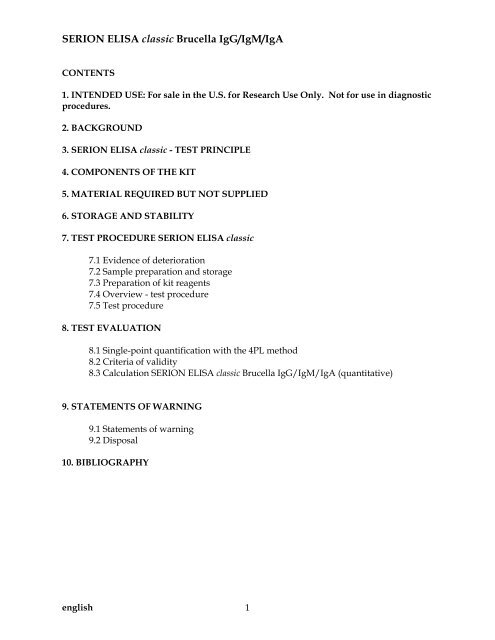

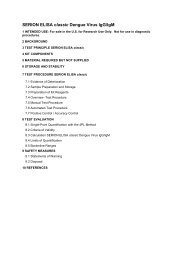
![MIKROGEN recomBlot CMV IgG [Avidity] recomBlot CMV IgM ...](https://img.yumpu.com/47840028/1/185x260/mikrogen-recomblot-cmv-igg-avidity-recomblot-cmv-igm-.jpg?quality=85)
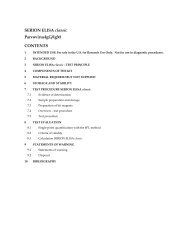
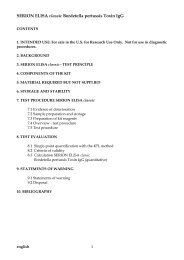
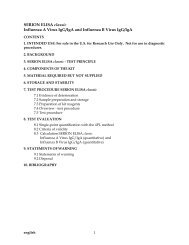

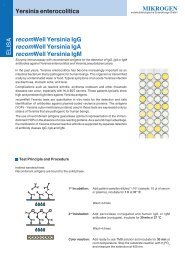
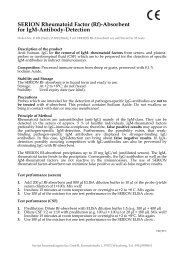

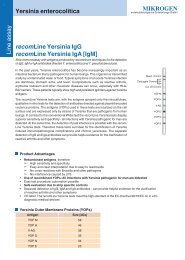
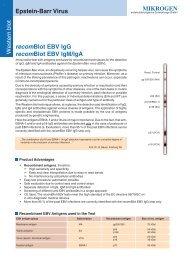

![MIKROGEN recomLine Parvovirus B19 IgG [Avidity] recomLine ...](https://img.yumpu.com/31102785/1/185x260/mikrogen-recomline-parvovirus-b19-igg-avidity-recomline-.jpg?quality=85)